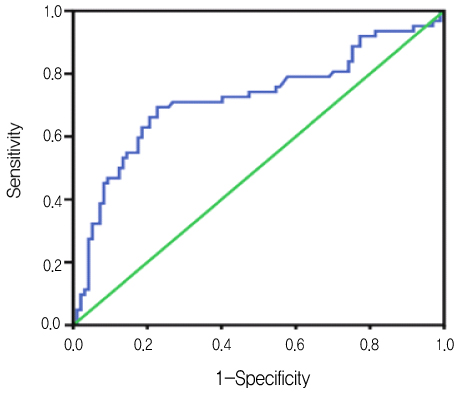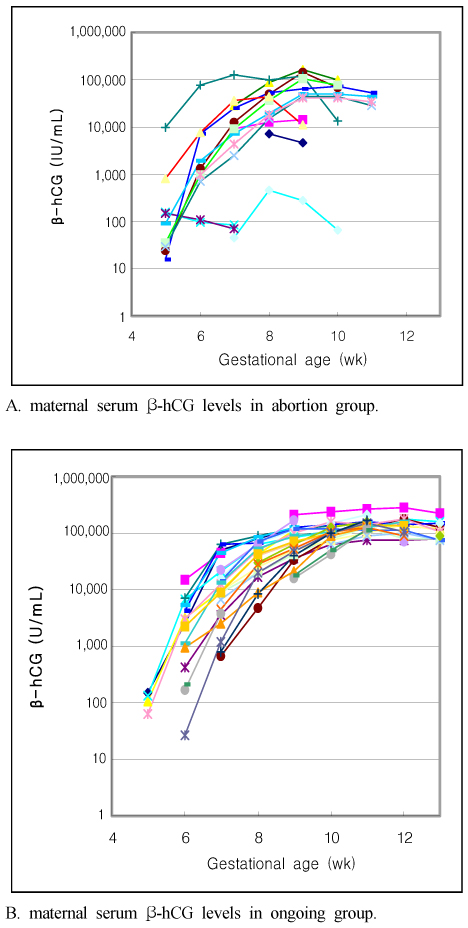Korean J Obstet Gynecol.
2010 Jun;53(6):497-505. 10.5468/kjog.2010.53.6.497.
The predictive efficacy of maternal serum CA125 in intrauterine early pregnancy with vaginal bleeding
- Affiliations
-
- 1Department of Obstetrics and Gynecology, Hallym University College of Medicine, Seoul, Korea. obgyn25@hallym.or.kr
- KMID: 2273889
- DOI: http://doi.org/10.5468/kjog.2010.53.6.497
Abstract
OBJECTIVE
To investigate whether sudden rise or already increased level of maternal serum CA125 predicts spontaneous abortion in early pregnancy with vaginal bleeding. And if so, to decide the CA125 cut-off level for poor pregnancy outcomes.
METHODS
The prospective study was performed in forty women presenting with any vaginal bleeding at early pregnancy. Maternal serum CA125 levels were evaluated on the first visit and followed up during the first trimester, or until the time to diagnose abortion. Serial maternal serum beta-hCG and ultrasonographic evaluation were also performed at the same time.
RESULTS
There were eventually fourteen abortions and twenty-six ongoing pregnancies. Using receiver-operating characteristic curve, 150 U/mL of serum CA125 was the most useful value for predicting spontaneous abortion. In most of abortion women, the serum CA125 level was increased over than 150 U/mL immediately before the abortion. The twelve of 17 women who were 150 U/mL or more resulted in abortion, while there were just two cases of abortion among 23 women who were less than 150 U/mL. Its positive predictive value was 70.6% and negative predictive value was 91.3% respectively (P<0.01).
CONCLUSION
There was a strong correlation between high level of serum CA125 and subsequent spontaneous abortion in early pregnancy. It should be valuable to check maternal serum CA125 added to beta-hCG and ultrasound for predicting pregnancy outcome at the early pregnancy, especially in the cases with vaginal bleeding.
Keyword
MeSH Terms
Figure
Reference
-
1. Wilcox AJ, Weinberg CR, O'Connor JF, Baird DD, Schlatterer JP, Canfield RE, et al. Incidence of early loss of pregnancy. N Engl J Med. 1988. 319:189–194.2. Tong S, Kaur A, Walker SP, Bryant V, Onwude JL, Permezel M. Miscarriage risk for asymptomatic women after a normal first-trimester prenatal visit. Obstet Gynecol. 2008. 111:710–714.3. Gracia CR, Sammel MD, Chittams J, Hummel AC, Shaunik A, Barnhart KT. Risk factors for spontaneous abortion in early symptomatic first-trimester pregnancies. Obstet Gynecol. 2005. 106:993–999.4. Pittaway DE, Wentz AC. Evaluation of early pregnancy by serial chorionic gonadotropin determinations: a comparison of methods by receiver operating characteristic curve analysis. Fertil Steril. 1985. 43:529–533.5. de Crespigny LC. Early diagnosis of pregnancy failure with transvaginal ultrasound. Am J Obstet Gynecol. 1988. 159:408–409.6. Kadar N, DeCherney AH, Romero R. Receiver operating characteristic (ROC) curve analysis of the relative efficacy of single and serial chorionic gonadotropin determinations in the early diagnosis of ectopic pregnancy. Fertil Steril. 1982. 37:542–547.7. Pittaway DE, Wentz AC, Maxson WS, Herbert C, Daniell J, Fleischer AC. The efficacy of early pregnancy monitoring with serial chorionic gonadotropin determinations and real-time sonography in an infertility population. Fertil Steril. 1985. 44:190–194.8. Schmidt T, Rein DT, Foth D, Eibach HW, Kurbacher CM, Mallmann P, et al. Prognostic value of repeated serum CA 125 measurements in first trimester pregnancy. Eur J Obstet Gynecol Reprod Biol. 2001. 97:168–173.9. Check JH, Nowroozi K, Vaze M, Wapner R, Seefried L. Very high CA 125 levels during early first trimester in three cases of spontaneous abortion with chromosomal abnormalities. Am J Obstet Gynecol. 1990. 162:674–675.10. Bast RC Jr, Feeney M, Lazarus H, Nadler LM, Colvin RB, Knapp RC. Reactivity of a monoclonal antibody with human ovarian carcinoma. J Clin Invest. 1981. 68:1331–1337.11. Chen DX, Schwartz PE, Li XG, Yang Z. Evaluation of CA 125 levels in differentiating malignant from benign tumors in patients with pelvic masses. Obstet Gynecol. 1988. 72:23–27.12. Vasilev SA, Schlaerth JB, Campeau J, Morrow CP. Serum CA 125 levels in preoperative evaluation of pelvic masses. Obstet Gynecol. 1988. 71:751–756.13. Moloney MD, Thornton JG, Cooper EH. Serum CA 125 antigen levels and disease severity in patients with endometriosis. Obstet Gynecol. 1989. 73:767–769.14. O'Brien TJ, Hardin JW, Bannon GA, Norris JS, Quirk JG Jr. CA 125 antigen in human amniotic fluid and fetal membranes. Am J Obstet Gynecol. 1986. 155:50–55.15. Quirk JG Jr, Brunson GL, Long CA, Bannon GA, Sanders MM, O'Brien TJ. CA 125 in tissues and amniotic fluid during pregnancy. Am J Obstet Gynecol. 1988. 159:644–649.16. Jacobs IJ, Fay TN, Yovich J, Stabile I, Frost C, Turner J, et al. Serum levels of CA 125 during the first trimester of normal outcome, ectopic and anembryonic pregnancies. Hum Reprod. 1990. 5:116–122.17. Fleuren GJ, Nap M, Aalders JG, Trimbos JB, de Bruijn HW. Explanation of the limited correlation between tumor CA 125 content and serum CA 125 antigen levels in patients with ovarian tumors. Cancer. 1987. 60:2437–2442.18. Chung TK, Sahota DS, Lau TK, Mongelli JM, Spencer JA, Haines CJ. Threatened abortion: prediction of viability based on signs and symptoms. Aust N Z J Obstet Gynaecol. 1999. 39:443–447.19. Farrell T, Owen P. The significance of extrachorionic membrane separation in threatened miscarriage. Br J Obstet Gynaecol. 1996. 103:926–928.20. Jouppila P, Huhtaniemi I, Tapanainen J. Early pregnancy failure: study by ultrasonic and hormonal methods. Obstet Gynecol. 1980. 55:42–47.21. Nanbu Y, Fujii S, Konishi I, Nonogaki H, Mori T. CA 125 in the epithelium closely related to the embryonic ectoderm: the periderm and the amnion. Am J Obstet Gynecol. 1989. 161:462–467.22. Kobayashi F, Sagawa N, Nakamura K, Nonogaki M, Ban C, Fujii S, et al. Mechanism and clinical significance of elevated CA 125 levels in the sera of pregnant women. Am J Obstet Gynecol. 1989. 160:563–566.23. Bon GG, Kenemans P, Verstraeten AA, Go S, Philipi PA, van Kamp GJ, et al. Maternal serum Ca125 and Ca15-3 antigen levels in normal and pathological pregnancy. Fetal Diagn Ther. 2001. 16:166–172.24. Spitzer M, Kaushal N, Benjamin F. Maternal CA-125 levels in pregnancy and the puerperium. J Reprod Med. 1998. 43:387–392.25. Spencer K, Muller F, Aitken DA. Amniotic fluid and maternal serum levels of CA125 in pregnancies affected by Down syndrome: a re-evaluation of the role of CA125 in Down syndrome screening. Prenat Diagn. 1997. 17:701–706.26. Goldstein I, Zimmer EA, Tamir A, Peretz BA, Paldi E. Evaluation of normal gestational sac growth: appearance of embryonic heartbeat and embryo body movements using the transvaginal technique. Obstet Gynecol. 1991. 77:885–888.27. Moon ZS, Lee SH, Park HM, Bae DH. The study on transvaginal ultrasonography and serum HCG in normal early pregnancy. Korean J Obstet Gynecol. 1993. 36:184–195.28. Braunstein GD, Rasor J, Danzer H, Adler D, Wade ME. Serum human chorionic gonadotropin levels throughout normal pregnancy. Am J Obstet Gynecol. 1976. 126:678–681.
- Full Text Links
- Actions
-
Cited
- CITED
-
- Close
- Share
- Similar articles
-
- Insulin-like Growth Factor Binding Protein-1 ( IGF-BP-1 ) in Maternal Serum of Women with Pregnancy Induced Hypertension
- Comparison of Abdominal and Vaginal Sonography in Normal and Abnormal Early Pregnancy
- Ectopic Implantation of Chorionic Villi presenting as Hemorrhagic Vaginal Mass associated with Second Trimester of Normal Pregnancy
- Diagnostic accuracy of beta-hCG discriminatory zone and vaginal ultrasound in abnormal early pregnancy
- Primary Ovarian Pregnancy with Intrauterine Device




